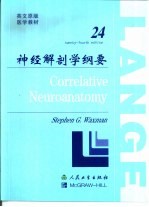图书介绍
神经解剖学纲要 英文版PDF|Epub|txt|kindle电子书版本网盘下载

- StephenG.Waxman编著 著
- 出版社: 北京:人民卫生出版社
- ISBN:7117045639
- 出版时间:2001
- 标注页数:394页
- 文件大小:125MB
- 文件页数:405页
- 主题词:
PDF下载
下载说明
神经解剖学纲要 英文版PDF格式电子书版下载
下载的文件为RAR压缩包。需要使用解压软件进行解压得到PDF格式图书。建议使用BT下载工具Free Download Manager进行下载,简称FDM(免费,没有广告,支持多平台)。本站资源全部打包为BT种子。所以需要使用专业的BT下载软件进行下载。如BitComet qBittorrent uTorrent等BT下载工具。迅雷目前由于本站不是热门资源。不推荐使用!后期资源热门了。安装了迅雷也可以迅雷进行下载!
(文件页数 要大于 标注页数,上中下等多册电子书除外)
注意:本站所有压缩包均有解压码: 点击下载压缩包解压工具
图书目录
SECTION Ⅰ.BASIC PRINCIPLES1
1.Fundamentals of the Nervous System1
General Plan of the Nervous System1
Peripheral Nervous System6
Structure, Function, and Dysfunction of the Nervous System6
References7
2.Elements of Nervous Tissue8
Cellular Aspects of Neural Development8
Neurons8
Neuronal Groupings and Connections12
Neuroglia13
Metabolic Features of the Brain17
References19
Membrane Potential20
3.Slgnaling in the Nervous System20
Generator Potential21
Action Potential22
The Nerve Cell Membrane Contains Ion Channels22
The Effects of Myelination23
Conduction of Action Potentials23
Clinical Illustration 3-126
Synapses27
Synaptic Transmission27
Excitatory and Inhibitory Synaptic Actions28
Synaptic Plasticity and Long-term Potentiation29
Presynaptic Inhibition29
The Neuromuscular Junction and the End-plate Potential30
Neurotransmitters31
References34
Case 134
SECTIONⅡ.INTRODUCTION TO CLINICAL THINKING35
4.Introduction to Clinical Thinking: The Relationship Between Neuroanatomy and Neurology35
Symptoms and Signs of Neurologic Diseases35
Where is the Lesion?38
What is the Lesion?39
The Role of Neuroimaging and Laboratory Investigations41
Clinical Illustration 4-142
Clinical Illustration 4-242
The Treatment of Patients With Neurologic Disease43
Clinical Illustration 4-343
References44
External Anatomy of the Spinal Cord45
Development of the Spinal Cord45
5.The Spinal Cord45
SECTIONⅢ. SPINAL CORD AND SPINE45
Spinal Roots and Nerves48
Internal Divisions of the Spinal Cord50
Pathways in White Matter52
Clinical Illustration 5-158
Reflexes58
Lesions in the Motor Pathways63
Examples of Specific Spinal Cord Disorders66
Case 267
Case 368
References68
6.The Spinal Cord in Situ Imaging69
Investing Membranes69
Clinical Illustration 6-170
Spinal Cord Circulation71
The Vertebral Column72
Lumbar Punctrue74
Imaging of the Spine and Spinal Cord76
Case 476
Case 577
References80
SECTIONⅣ. ANATOMY OF THE BRAIN81
7.The Brain Stem and Cerebelium81
Development of the Brain Stem and Cranial Nerves81
Organization of the Brain Stem81
Cranial Nerve Nuclei in the Brain Stem84
Medulla86
Pons89
Midbrain90
Vascularization91
Clinical Illustration 7-192
Clinical Illustration 7-293
Cerebellum94
Case 6100
Case 7100
References102
8.Cranial Nerves and Pathways103
Origin of Cranial Nerve Fibers103
Functional Components of the Cranial Nerves103
Anatomic Relationships of the Cranial Nerves106
Case 8121
Case 9122
References122
Thalamus123
9.Diencephalon123
Hypothalamus126
Subthalamus131
Epithalamus132
Circumventricular Organs133
Case 10133
References134
10.Cerebral Hemispheres/Teiencephaion135
Development135
Anatomy of the Cerebral Hemispheres135
Microscopic Structure of the Cortex141
Physiology of Specialized Cortical Regions146
Basal Ganglia147
Internal Capsule150
Case 12151
Case 11151
References152
11.Ventricles and Coverings of the Brain153
Ventricular System153
Meninges and Spaces155
Cerebrospinal Fluid157
Barriers in the Nervous System158
Skull161
Case 13166
Case 14166
References167
12.Vascuiarization168
Arterial Supply of the Brain168
Venous Drainage172
Cerebrovascular Disorders175
Clinical Illustration 12-1180
Case 16186
Case 15186
References187
SECTIONⅤ. FUNCTIONAL SYSTEMS189
13.Control of Movement189
Control of Movement189
Major Motor Systems189
Motor Disturbances195
Case 17200
Case 18200
References200
14.Somatosensory systems202
Sensation202
Pain204
References207
Case 19207
Case 20207
15.The Visual System208
The Eye208
Visual Pathways214
Clinical Illustration 15-1218
The Visual Cortex218
Case 21221
Referecces221
16.The Auditory System222
Anatomy and Function222
Auditory Pathways223
Case 22226
References226
Functions227
Vestibular Pathways227
17.The Vestibular System227
Anatomy227
Case 23229
References230
18.The Reticular Formation231
Anatomy231
Functions231
Case 24234
References235
19.The Limbic System236
The Limbic Lobe and Limbic System236
Olfactory System236
Clinical Illustration 19-1239
Hippocampal Formation239
Functions and Disorders245
Case 25246
References247
20.The Autonomic Nervous System248
Autonomic Outflow248
Autonomic Innervation of the Head254
Visceral Afferent Pathways255
Transmitter Substances256
Hierarchical Organization and Control of the Autonomic Nervous System259
Case 26263
References263
21.Higher Cortical Functions264
Frontal Lobe Functions264
Language and Speech264
Memory and Learning270
Cerebral Dominance270
Epilepsy271
Clinical Illustration 21-1273
Case 27275
Case 28275
References275
22.Aging, Degeneration, Regeneration, and Piasticity276
Neurobiology of Aging276
Dementia278
Neurotrophic Factors280
Degeneration and Regeneration282
Neurogenesis284
Clinical Illustration 22-1284
Neural Plasticity285
References286
Case 29286
SECTIONⅥ. DIAGNOSTIC AIDS287
23.Imaging of the Brain287
Skull X-rays287
Angiography287
Ultrasonography290
Computed Tomography290
Magnetic Resonance Imaging293
Magnetic Resonance Spectroscopy295
Diffusion-Weighted Imaging295
Functional Magnetic Resonance. Imaging295
Positron Emission Tomography296
Single Photon Emission Computed Tomography297
References299
Electroencephalography300
24.Electrodiagnostic Tests300
Evoked Potentials301
Tanscranial Motor Cortical Stimulation303
Electromyography305
Nerve Conduction Studies307
References308
25.Cerebrospinal Fluid Examination309
Indications309
Contraindications309
Analysis of the CSF309
References310
SECTIONⅦ. DISCUSSION OF CASES311
26.Discussion of Cases311
The Location of Lesions311
The Nature of Lesions312
Cases313
References329
Appendix A: The Neuroiogic Examination331
Examining Children and Adults331
History331
The Physical Examination331
The Neurologic Examination332
Examining Neonates336
General Status336
The Neurologic Examination336
Appendix B: Testing Muscle Function338
Appendix C: Spinal Nerves and Piexuses355
Appendix D: Questions and Answers372
Index381